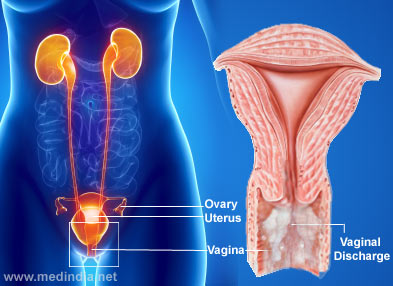- Merritt DF. Vulvovaginitis. In: Kliegman RM, Behrman RE, Jenson HB, Stanton BF, eds. Nelson Textbook of Pediatrics. 19th ed. Philadelphia, Pa: Saunders Elsevier; 2011:chap 543.
- Centers for Disease Control and Prevention: ''Sexually Transmitted Diseases Treatment Guidelines", 2010.
- National Institutes of Health: ''What is Vaginitis?'' American Family Physician, 2004; vol 69: pp 2191-2192.
- Schrager SB, Paladine HL, Cadwallader K. Gynecology. In: Rakel RE, ed. Textbook of Family Medicine. 8th ed. Philadelphia, Pa: Saunders Elsevier; 2011:chap 25.
- Comprehensive Gynecology. 5th ed. Philadelphia, Pa: Mosby Elsevier; 2007:chap 22.
- Vaginal Discharge - (http://www.emedicinehealth.com/vaginal_discharge/page2_em.htm#vaginal_discharge_causes)
- Vaginal Discharge - (http://www.patient.co.uk/doctor/vaginal-discharge.htm)
About
Secretion of clear or whitish fluid from the vagina is termed as vaginal discharge. This is usually a normal phenomenon; most women have vaginal discharge, especially those of childbearing age. The amount, consistency, colour and smell of discharge vary among women.

Glands in the cervix produce mucus. This may normally change its colour to white or yellow on exposure to air. The amount of mucus changes throughout the menstrual cycle. Discharge would be more during ovulation, breastfeeding, or sexual arousal. The walls of the vagina may also make some secretions.
The following conditions normally increase vaginal discharge:
- Emotional stress
- Ovulation: Ovulation is the release of egg from the ovary that occurs in the middle of the menstrual cycle, usually on the 14th day for a 28 days long cycle.
- Pregnancy
- Sexual arousal
However, not all vaginal discharge is normal.
A sudden change in colour, consistency, odour, or a marked increase or decrease in the amount of vaginal discharge may be abnormal.
The doctor takes a detailed medical history of your symptoms. He may ask you a number of questions like: When did it start? What was the colour? Did it have an abnormal smell? Did you douche? Did you have itching, pain or burning sensations? Did you have any medications recently? Did you have sex with more than one sexual partner?
A sample of the discharge is usually taken for detailed examination. A Pap test is also done; cells are collected from the cervix (This is a very vital examination that can help in the diagnosis of a cancer).
Treatment is based on the underlying cause of abnormal discharge. A bacterial infection requires antibiotic agents. Drugs like metronidazole or tinidazole are usually used to treat trichomonas infection. Antifungal medications are available as pills, creams or gel forms.
Causes for Abnormal Vaginal Discharge
The causes of abnormal vaginal discharge are listed below:
Infection of the vagina and cervix: Presence of an infective agent in the vagina or cervix disturbs the normal vaginal bacterial balance resulting in abnormal vaginal discharge. These infections include:
- Bacterial vaginosis: Bacterial vaginosis is one of the commonest causes of vaginal discharge in women of child bearing age. Douching, new or multiple sex partners are risk factors for the condition (cause for these associations are unknown). The discharge is usually thin with a foul smell and usually not associated with itching.
- Sexually transmitted diseases (STDs): Sexually transmitted diseases such as those caused by Chlamydia, Gonorrhoea and Trichomonas vaginalis are associated with abnormal vaginal discharge. The discharge is usually yellowish in color and may be accompanied by burning and itching in the vaginal area. The patient may also have a urinary tract infection.
- Infections caused by yeast: Yeast infections of the vagina result in thick, white curdy discharge that is often odourless. The patient may complain of itching and pain during intercourse. Women with diabetes or who were on antibiotics may be predisposed to developing yeast infection.
Other causes of abnormal vaginal discharge are-
Cancer of the cervix: Cancer of the cervix or the inner lining of the uterus may result in bloody or brownish colored vaginal discharge.
Post medication intake: Intake of certain medications like birth control pills or antibiotics may be associated with abnormal vaginal discharge. In addition, local use of douches, scented soaps and lotions, and bubble baths may also result in abnormal vaginal discharge. A history of use of these substances should be elicited from the patient.
Foreign Body: The presence of a foreign body within the vagina can result in an abnormal vaginal discharge. The discharge may be brownish in color and foul-smelling. The condition can be diagnosed on examination.
Fistula: A fistula is an abnormal connection between the vagina and either the lower urinary or digestive tract. A history of trauma to the area or prior surgery may be obtained from the patient. The vaginal discharge may contain feces in some cases.
Frequently Asked Questions
1. Can a woman have multiple infections at the same time?
Yes. More than one organism may infect the vagina at the same time. This is more common in the women with a compromised immune system, as in those affected with HIV.
2. Once cured, can I get further attacks of abnormal vaginal discharge?
Yes. As already discussed, there are multiple causes for abnormal discharge. This means that once a specific cause is treated, other causes may walk in at other times. So always follow safe practices and take precautions.
3. How can abnormal vaginal discharge be prevented?
Abnormal vaginal discharge can be prevented by taking the following precautions-
- Keep the vagina clean; use gentle, mild soap and warm water to wash your vagina regularly. Always wipe from front to back; this prevents bacteria from entering the vagina.
- Avoid douche, scented soaps, feminine sprays, bubble bath
- Use 100% cotton underpants, avoid overly tight clothing
- Practice safe sex
- Take medications only after consultations with your doctor











